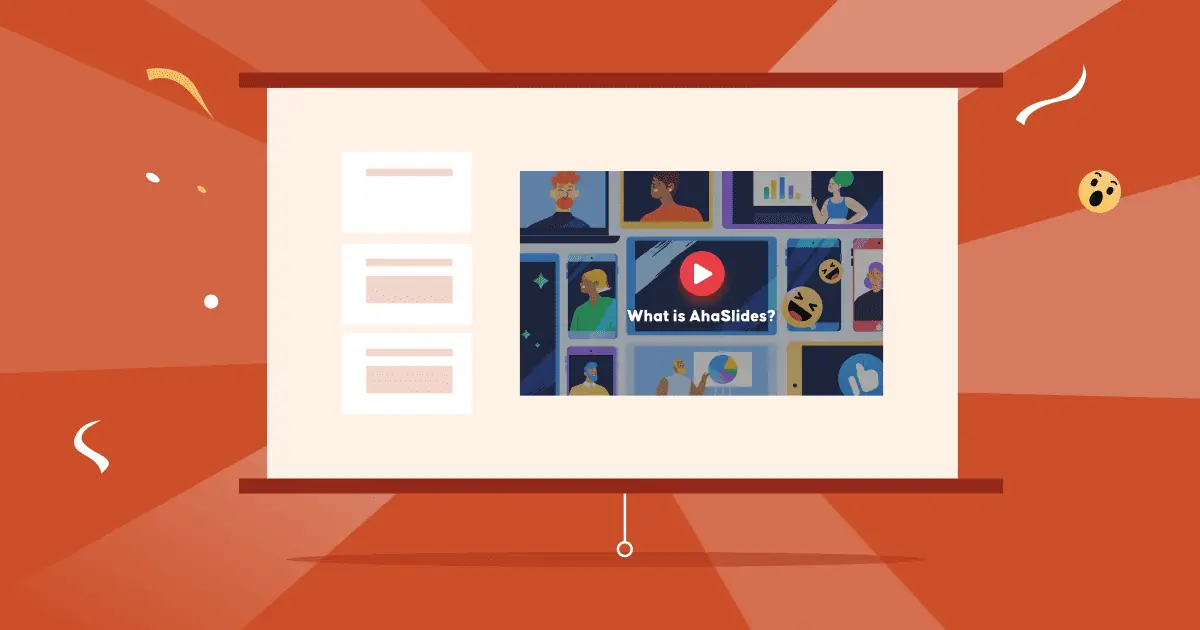كيف تناقش للمبتدئين؟ الجدال موضوعٌ شائكٌ للغاية. إذا لم تُجرِبْه من قبل، فقد يكون من المُرهق التفكير فيما سيحدث وكيف يُمكنك تجنُّب الظهور بمظهرٍ مُشتتٍ أمام الجميع.
هناك الكثير لتتعلمه قبل أن تستجمع شجاعتك للوقوف على المنصة. لكن لا تقلق؛ سيقدم لك هذا الدليل للمبتدئين في المناظرات الخطوات والنصائح والأمثلة اللازمة لإنجاح مناظرتك القادمة. لذا، لنلقِ نظرة على هذه النصائح الرائعة للمناظرات!
جدول المحتويات
- 7 خطوات لاقامة مناظرة للمبتدئين
- 10 نصائح للمناظرين الجدد
- 6 أنماط من المناظرات
- 2 أمثلة المناقشة
- مزيد من النصائح مع AhaSlides
مزيد من النصائح مع AhaSlides

ابدأ في ثوان.
احصل على قوالب مناظرات طلابية مجانية. اشترك مجانًا واحصل على ما تريد من مكتبة القوالب!
🚀 احصل على قوالب مجانية ☁️
كيف يعمل النقاش للمبتدئين (في 7 خطوات)
قبل أن تبدأ بتعلم كيفية صياغة حججك باحترافية، عليك أن تعرف كيفية إجراء مناظرة للمبتدئين. اطلع على هذه الخطوات السبع للمناظرة للمبتدئين وما عليك فعله خلال هذه العملية، وستفهم تمامًا كيف تصبح مناظرًا أفضل!
1. تم تحديد الغرض

بما أننا نستخدم المناظرات في أماكن ومواقف عديدة، مثل المدارس واجتماعات الشركات وحلقات النقاش والهيئات السياسية، فمن الضروري تحديد الأهداف الرئيسية للمناظرة أولاً. فهذا يُعطي رؤية واضحة لخطة وتنظيم المناظرات، نظرًا لوجود العديد من التفاصيل التي يجب العمل عليها لاحقًا، والتي يجب أن تكون جميعها متناسقة.
لذا، قبل أي شيء، سوف يجيب الميسر على هذا السؤال: ما هي أهداف هذا النقاش?
على سبيل المثال ، إذا كنت في نطاق مناظرة طلابيةينبغي أن تكون أهداف الدرس مطابقة لأهدافك، والتي قد تتمثل في تشجيع الطلاب على التفكير النقدي ومهارات التحدث أمام الجمهور. أما في العمل، فقد يكون اختيار أي من الفكرتين مناسبًا.
2. تم اختيار الهيكل
عند السؤال عن كيفية المناظرة الجيدة، يجب أن يكون لديك هيكل مُحكم. هناك العديد من أشكال هيكلة المناظرة، وأنماطها المتعددة. من المهم أن تعرف بعض المصطلحات الأساسية المستخدمة في العديد من أنواع المناظرات الشائعة قبل الاستعداد لها.
- الموضوع - كل نقاش له موضوع، والذي يسمى رسميًا اقتراح or قراريمكن أن يكون الموضوع عبارة عن بيان أو سياسة أو فكرة، ويعتمد ذلك على إعداد المناقشة وهدفها.
- أنظمة فريق - اثبات (دعم الحركة) و سلبي (معارضة الحركة). في كثير من الحالات ، يتكون كل فريق من ثلاثة أعضاء.
- القضاة or القضاة: الأشخاص الذين يحكمون على نوعية الحجج في الأدلة وأداء المناظرين.
- ناظما - الشخص الذي يتابع الوقت ويوقف الفرق عندما ينتهي الوقت.
- المراقبين - يمكن أن يكون هناك مراقبون (جمهور) في المناقشة، ولكن لا يُسمح لهم بالتدخل.
بالنسبة إلى مناظرة المبتدئين ، بعد تلقي الاقتراح ، سيكون لدى الفرق الوقت للاستعداد. ال اثبات يبدأ الفريق المناقشة مع المتحدث الأول ، متبوعًا بالمتحدث الأول من سلبي فريق. ثم يذهب إلى المتحدث الثاني في اثبات فريق العودة إلى المتحدث الثاني في سلبي فريق ، وهلم جرا.
سيتحدث كل متحدث ويقدم نقاطه في الوقت المحدد المنصوص عليه في قواعد المناقشة. ضع في اعتبارك أن لا الكل المناقشات تنتهي مع الفريق سلبي؛ في بعض الأحيان ، فريق اثبات سيطلب إنهاء.
نظرًا لأنك ربما تكون جديدًا في هذا الأمر، يمكنك العثور على عملية المناقشة للمبتدئين أقل منمن السهل متابعتها ويمكن استخدامها في العديد من أنواع المناقشات المختلفة.
3. تم وضع خطة المناقشة
لكي تسير المناقشة بسلاسة، يجب أن يكون لدى الميسر خطة بأكبر قدر ممكن من التفاصيليجب عليهم أن يطلعوك على هذه الخطة، لأنها ستساعدك على تصور كل شيء وتمنعك من الخروج عن المسار، وهو أمر سهل للغاية عندما تشارك في مناظرة للمبتدئين.
فيما يلي قائمة مرجعية بسيطة لما يجب أن تتضمنه الخطة:
- الغرض من المناقشة
- الهيكل
- كيف سيتم تجهيز الغرفة
- الجدول الزمني والتوقيت لكل فترة
- قواعد وتعليمات المناقشة الرسمية للمتحدثين والمحكمين
- قوالب تدوين الملاحظات للأدوار
- ملخص لغلق المناقشة عند انتهائها
4. الغرفة مرتبة
إن البيئة ضرورية للمناظرة لأنها يمكن أن تؤثر على أداء المتحدثين إلى حد ما.
ينبغي أن يكون جوّ مناظرتكم احترافيًا قدر الإمكان. هناك طرق عديدة لتجهيز قاعة مناظرات، ولكن أيًا كان الإعداد المُختار، سيتمحور كل شيء حول "منطقة المتحدثين" في المنتصف. هنا سيُحدث سحر المناظرة.
سيقف كل متحدث يمثل الفريقين في منطقة المتحدث أثناء دوره ، ثم يعود إلى مقعده عند الانتهاء.
وفيما يلي مثال تخطيط شائع لمناقشة المبتدئين:
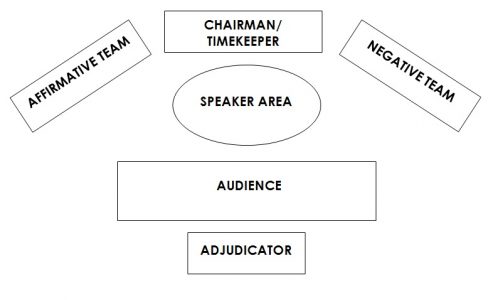
بالطبع، هناك دائمًا خيار عقد مناظرة عبر الإنترنت. قد تجد صعوبة في الشعور بنفس الأجواء في مناظرة للمبتدئين عبر الإنترنت، ولكن هناك بعض الطرق لإضفاء بعض الإثارة:
- تخصيص الخلفية: قد يكون لكل دور خلفية تكبير مختلفة: المضيف ، وضابط الوقت ، والمحكمون وكل فريق. يمكن أن يساعد ذلك في التمييز بين أدوار كل مشارك وإلهام بعض الفخر بالدور الممنوح له.
- أجهزة الدعم:
- الموقت: التوقيت مهم في المناقشة ، خاصة للمبتدئين في أول مرة. قد يقرر الميسر الخاص بك تتبع وتيرتك بمؤقت على الشاشة (على الرغم من أنه في معظم المناقشات ، يشير ضابط الوقت فقط عندما يتبقى دقيقة واحدة أو 1 ثانية).
- مؤثرات صوتية: تذكر أن هذه مجرد مناقشة للمبتدئين. يمكنك أن تتوقع من ميسرك أن يخفف الجو بالتشجيع المؤثرات الصوتية التصفيق عندما ينهي المتحدث حديثه.
5. يتم اختيار الفرق
سيتم تقسيم الفرق إلى اثبات و سلبي. عادةً ما يتم اختيار الفرق ومواقع المتحدثين داخل هذه الفرق بشكل عشوائي ، لذلك قد يستخدم المنسق الخاص بك ملف عجلة دوارة لجعل العملية أكثر إثارة وجاذبية.
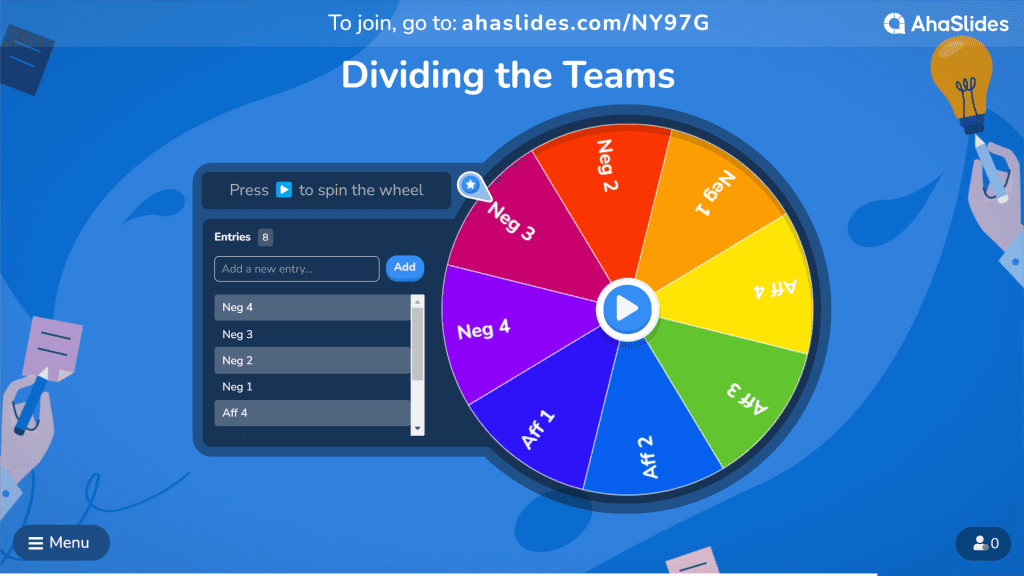
بعد اختيار الفريقين، سيتم الإعلان عن الاقتراح وسيتم منحك بعض الوقت للتحضير، ويفضل ساعة واحدة.
في هذا الوقت ، سيشير المنسق إلى الكثير من الموارد المختلفة حتى تتمكن الفرق من فهم السياق والمشكلات لتكوين نقاط أقوى. كلما عرفت أكثر ، زادت قوة النقاش.
6. يبدأ النقاش
يتطلب كل نوع مختلف من المناظرة شكلاً آخر، ويمكن أن يكون هناك الكثير من الاختلافات. يوجد أدناه إصدار شائع جدًا يمكن استخدامه في أي نقاش للمبتدئين.
لكل فريق أربع دورات للتحدث في هذه المناظرة، لذا يُفضل أن يكون عدد المتحدثين ستة أو ثمانية. في حال وجود ستة متحدثين، سيتحدث اثنان من المناقشين مرتين.
| خطاب | الوقت: | مسؤوليات المناظرين |
| الأول الإيجابي البناء | 8 دقيقة | قدم الحركة ووجهة نظرهم أعط تعريفاتهم للمصطلحات الأساسية قدم حججهم لدعم الحركة |
| أول سلبي بناء | 8 دقيقة | اذكر حججهم لمعارضة الاقتراح |
| 2 الإيجابي البناء | 8 دقيقة | عرض المزيد من الحجج لدعم الاقتراح وآراء الفريق تحديد مناطق الصراع أجب عن أسئلة المتحدث السلبي (إن وجد) |
| 2 سلبي بناء | 8 دقيقة | وضع المزيد من الحجج ضد الاقتراح وتعزيز آراء الفريق تحديد مناطق الصراع أجب عن أسئلة المتحدث الإيجابي (إن وجد) |
| أول نقض سلبي | 4 دقيقة | الدفاع عن سلبي حجج الفريق وإحباط الحجج الداعمة دون إضافة حجج أو معلومات جديدة |
| 1 نقض إيجابي | 4 دقيقة | الدفاع عن اثبات حجج الفريق وهزيمة الحجج المعارضة دون إضافة حجج أو معلومات جديدة |
| ثاني نقض سلبي (كلمة الختام) | 4 دقيقة | احصل على دحض ثاني وبيانات ختامية |
| 2 نقض إيجابي (كلمة الختام) | 4 دقيقة | احصل على دحض ثاني وبيانات ختامية |
؟؟؟؟ يمكن أن يكون هناك وقت قصير للتحضير قبل عمليات الطعن ، اعتمادًا على القواعد.
يمكنك مشاهدة فيديو مثال على هذا التنسيق هنا بالأسفل.
7. التحكيم في المناقشة
حان وقت عمل المُحكِّمين. عليهم مُتابعة المُناظرات وأداء كل مُناظر، ثم تقييم أدائهم. هذه بعض الأمور التي سيُراعونها في أدائكم...
- التنظيم والوضوح - البنية وراء خطابك - هل من المنطقي أن تضعه بالطريقة التي فعلتها؟
- وصف المنتج - هذه الحجج والأدلة والاستجوابات والردود التي تقدمها.
- أسلوب التسليم والعرض - كيفية توصيل وجهة نظرك، بما في ذلك اللغة الشفهية والجسدية، ومحتوى العين، والنبرة المستخدمة.
10 نصائح للمناظرين الجدد
لا أحد يستطيع إتقان كل شيء من البداية، وإذا لم تناقش في حياتك، فالبدء ليس بالأمر السهل. إليك بعض الأمثلة: 10 نصائح سريعة لاكتشاف كيفية المناظرة بشكل فعال ويمكنه مواكبة المبتدئين في كل مناظرة.
#1 - التحضير هو المفتاح - ابحث عن الموضوع كثير مسبقًا للحصول ليس فقط على معلومات أساسية، ولكن أيضًا على الثقة. يمكن أن يساعد هذا المتناظرين المبتدئين على فهم القضايا بشكل أفضل ليكونوا بداية جيدة للتفنيد، ثم صياغة حججهم، والعثور على الأدلة، وتجنب الوقوع في فخ الأرانب. يجب على كل متناظر أن يحدد كل شيء في نقاط (من الأفضل 3 نقاط لثلاث حجج) لترتيب الأفكار بشكل أفضل ورؤية "الصورة الكبيرة" لخطابه.
#2 - حافظ على كل شيء في الموضوع من آفات المناظرات الخروج عن الموضوع، إذ يُضيّع وقتًا ثمينًا للحديث ويُضعف الحجة. انتبه للمُخططات والنقاط الرئيسية للتأكد من أنها تُناسب الموضوع وتُعالج المشاكل المُلحة.
#3 - اجعل نقاطك بأمثلة - وجود الأمثلة يجعل جمل المناقشة الخاصة بك أكثر إقناعًا، كما أن الناس يرون الأشياء بشكل أكثر وضوحًا، مثل المثال أدناه…
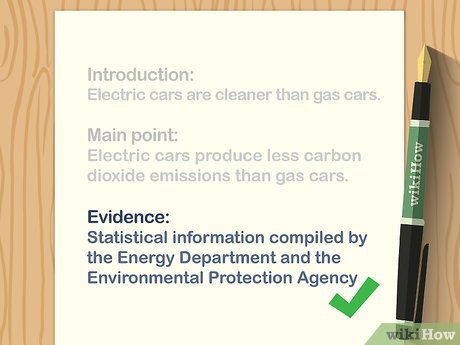
#4 - حاول التفكير مثل المعارضين أثناء مراجعة الأفكار، فكّر في النقاط التي قد يطرحها المعارضون. حدّد بعضًا منها، واكتب خريطة ذهنية للردود التي يمكنك تقديمها إذا لزم الأمر. do ينتهي الأمر بتوضيح تلك النقاط.
#5 - لديك استنتاج قوي أنهِ النقاش ببضع جمل جيدة، تُلخص على الأقل النقاط الرئيسية. في كثير من الأحيان، يُفضّل المُناظرون اختتام النقاش بجملة واحدة مُصاغة ببراعة تُثير الاهتمام. انخفاض هيئة التصنيع العسكري الوقت الحاضر (تحقق من هذا المثال أدناه).
#6 - كن واثقًا (أو افعلها حتى تصنعها!) من أهم عوامل التفوق في المناظرات هو أجواء النقاش. يجب أن يكون المناقشون واثقين مما يقولون، فالتفاخر يُؤثر بشكل كبير على الحكام والمراقبين. وبالطبع، كلما زاد استعدادك، زادت ثقتك بنفسك.
#7 - تكلم ببطء من المشاكل الشائعة جدًا لدى المُناظرين المبتدئين سرعة حديثهم. غالبًا ما تكون سرعتهم في الجولة الأولى عالية جدًا، مما يُسبب قلقًا للمستمعين والمتحدث على حد سواء. خذ نفسًا عميقًا وتحدث ببطء. قد لا تُقدم الكثير، لكن ما تُقدمه سيكون ذا وزن.
#8 - استخدم جسمك ووجهك لغة الجسد تدعم وجهة نظرك وتُظهر ثقتك بنفسك. انظر في عيون خصومك، واتخذ وضعية وقوف جيدة، وتحكم في تعابير وجهك (لا تكن عدوانيًا جدًا) لجذب الانتباه.
#9 - استمع بعناية وقم بتدوين الملاحظات يجب على المُناظرين الانتباه لكل خطاب وفكرة لمواكبة وتيرة النقاش، ودعم زملائهم، ودحض خصومهم بشكل أفضل. يُفيد تدوين الملاحظات كثيرًا، إذ لا يُمكن لأحد تذكّر كل نقطة للدحض أو التوسّع فيها. تذكّر تدوين النقاط الرئيسية فقط.
#10 - تجنب اللقطات الرخيصة ركّز على حجج خصومك ودحضها، لا على الخصوم أنفسهم. لا ينبغي للمناظرين الإساءة للآخرين؛ فهذا يُظهر نقصًا في الاحترافية، وستُعرّض نفسك للانتقاد الشديد.
6 أنماط من مناظرات المبتدئين
هناك العديد من أنماط المناقشات ذات الأشكال والقواعد المختلفة. إن معرفة بعضها بشكل كامل يمكن أن يساعد المتناظرين المبتدئين على رؤية العملية وما يتعين عليهم القيام به. فيما يلي بعض أساليب المناظرة الشائعة التي قد تراها في مناظرتك الأولى!
1. مناقشة السياسة هذا نوع شائع يتطلب بحثًا مكثفًا. يدور النقاش حول تطبيق سياسة معينة من عدمه، وعادةً ما يكون ذلك في فريق مؤلف من شخصين أو أكثر. مناقشة السياسة يتم استخدامه في العديد من المدارس لأنه عملي، وقواعده أسهل في المتابعة من الأنواع الأخرى.
2. نقاش برلماني يعتمد هذا الأسلوب في المناظرات على نموذج الحكومة البريطانية ومناظرات البرلمان البريطاني. وقد اعتمدته الجامعات البريطانية أولًا، وهو الآن الأسلوب الرسمي في العديد من مسابقات المناظرات الكبرى، مثل بطولة الجامعات العالمية للمناظرات وبطولة الجامعات الأوروبية للمناظرات. يتميز هذا الأسلوب بذكائه وقصر مدته عن الأسلوب التقليدي. سياسة النقاش ، مما يجعلها مناسبة للعديد من الحالات ، من المدارس المتوسطة إلى الجامعات.
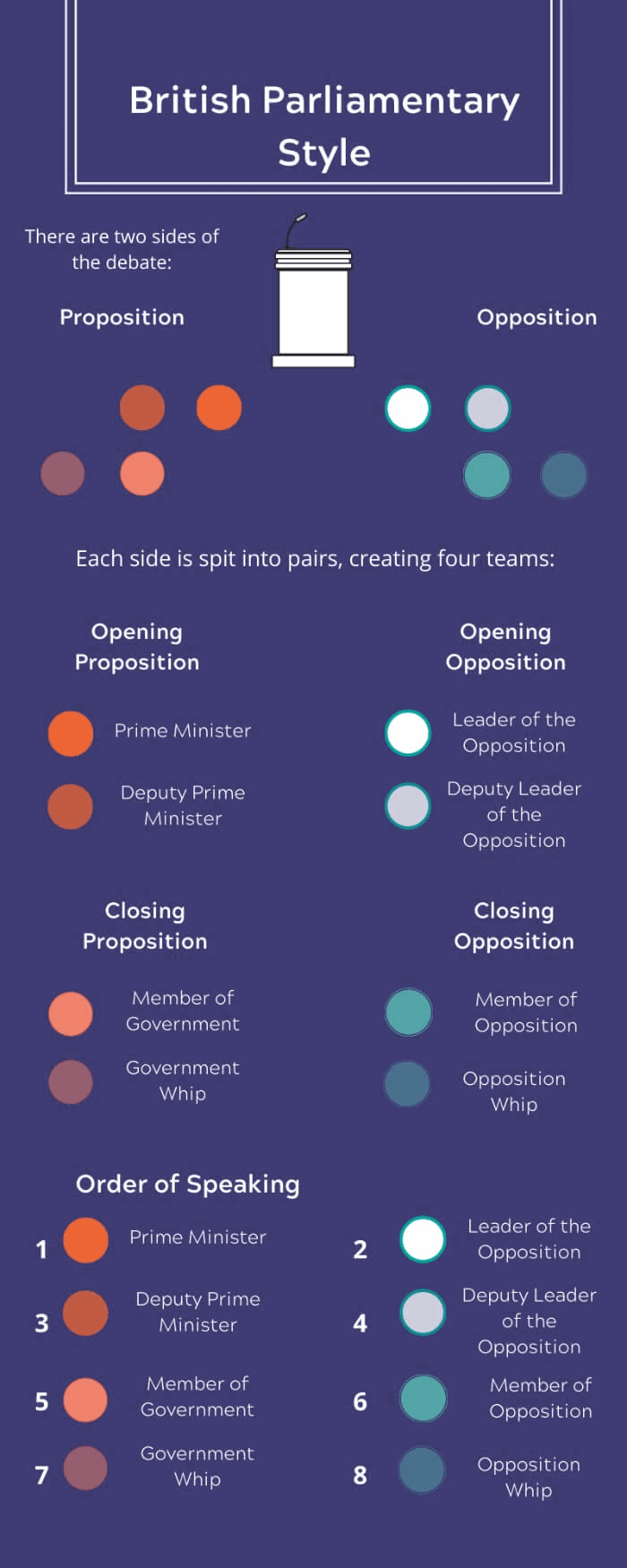
3. مناقشة المنتدى العام في هذا الأسلوب، يناقش فريقان مواضيع ساخنة ومثيرة للجدل أو قضايا جارية. هذه المواضيع هي التي يُحتمل أن يكون لديك رأي فيها، لذا فإن هذا النوع من النقاش أسهل من النقاش التقليدي. سياسة النقاش.
4. لينكولن دوغلاس مناقشةهذا أسلوب مناظرة مفتوح، فردي، سُمي تيمنًا بسلسلة مناظرات شهيرة جرت عام ١٨٥٨ بين مرشحي مجلس الشيوخ الأمريكي أبراهام لينكولن وستيفن دوغلاس. في هذا الأسلوب، يُركز المُناظرون على أسئلة أكثر عمقًا أو فلسفية، تتعلق غالبًا بقضايا مهمة.
5. عفوي الحجج يتجادل مُناظران حول موضوع مُحدد؛ عليهما صياغة حججهما في وقت قصير جدًا والرد بسرعة على أفكار خصومهما دون تحضير كبير. يتطلب هذا مهارات جدلية قوية، ويمكن أن يُساعد في تعزيز الثقة بالنفس والتغلب على رهبة المسرح.
6. الكونجرس مناقشة هذا الأسلوب يُحاكي الهيئة التشريعية الأمريكية، حيث يُحاكي المُناظرون أعضاء الكونغرس. يناقشون التشريعات، بما في ذلك مشاريع القوانين (مقترحات القوانين) والقرارات (بيانات المواقف). ثم يُصوّت الكونغرس المُحاكي على إقرارها، ثم يُواصل التصويت لصالحها أو ضدها.
2 أمثلة المناقشة
فيما يلي مثالان لبعض المناقشات حتى تتمكن من رؤية كيفية حدوثها بشكل أفضل ...
1. مناقشة البرلمان البريطاني
هذا مقطع قصير من مناظرة بين رئيسة الوزراء البريطانية السابقة تيريزا ماي وزعيم حزب العمال السابق، جيريمي كوربين. اتسمت المناظرة بأجواء حيوية ونقاشات حادة، وهو أمر شائع في هذا النوع من المناظرات الصاخبة. كما اختتمت ماي خطابها بتصريح قويّ انتشر على نطاق واسع!
2. المحاورون
مناظرات الطلاب أصبحت المناظرات المدرسية ظاهرة شائعة بشكل متزايد؛ حتى أن بعض المناظرات المُحكمة قد تكون جذابة بقدر مناظرات الكبار. هذا الفيديو هو حلقة من برنامج مناظرات فيتنامية باللغة الإنجليزية بعنوان "المناظرون". ناقش طلاب المرحلة الثانوية قضية "نُشيد بجريتا ثونبرغ" في إطار نقاش شائع جدًا بين ثلاثة طلاب.





